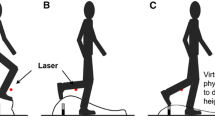Abstract
Information used to determine the action strategies necessary to successfully pass through apertures is based on the dimensions of the individual and the mover’s action capabilities (Warren in J Exp Psychol 10:683–703, 1984; Warren and Whang in J Exp Psychol 13:371–383, 1987). Previous research has demonstrated that when children must pass through small spaces, they will produce a shoulder rotation at apertures 1.6 times their shoulder width and smaller (i.e., critical point) and their avoidance strategies are based more on dynamic than geometric measures (Snapp-Childs and Bingham in Exp Brain Res 198:527–533, 2009; Wilmut and Barnett in Exp Brain Res 210:185–194, 2011). The question remains as to whether similar strategies exist when children are given a choice in their obstacle avoidance strategy. The current study aimed to determine the action strategies employed by children when confronted with a non-confined obstacle avoidance task. Specifically, the study intended to identify the aperture width that elicited a change in action (e.g., a shoulder rotation or a change in travel path). Children (N = 12, mean age = 7.1 years, ±0.2) were instructed to walk along a 10-m path toward a visible goal located at the end of the pathway and avoid colliding with the two vertical obstacles placed halfway (5 m) down the path on either side of the midline. The space between the obstacles ranged between 0.6 and 1.8 times the participant’s shoulder width (presented in increments of 0.2). Results revealed that when the aperture was too small for straight passage, children choose to circumvent the obstacles rather than rotate their shoulders the majority of the time. However, unlike young and older adults (Hackney and Cinelli in Gait Posture 37:93–97, 2013a, Exp Brain Res 225:419–429, 2013b), this strategy was not used consistently. Instead, changes in travel path were highly variable both across participants and within trials. This variability suggests that a true critical point cannot be established for children in this non-confined task. Variable actions at the time of crossing were significantly correlated with the medial–lateral center of mass variability during the approach to the obstacles. These results further support the idea that children’s actions may be more affected by dynamic factors than geometric measures.





Similar content being viewed by others
References
Cesari P, Formenti F, Olivato P (2003) A common perceptual parameter for stair climbing for children, young and old adults. Hum Mov Sci 22:111–124
Cinelli ME, Patla AE (2007) Travel path conditions dictate the manner in which individuals avoid collisions. Gait Posture 26:186–193
Franchak JM, Adolph KE (2012) What infants know and what they do: perceiving possibilities for walking through openings. Dev Psychol 48:1254
Franchak JM, Celano EC, Adolph KE (2012) Perception of passage through openings depends on the size of the body in motion. Exp Brain Res 223:301–310
Gerin-Lajoie M, Richards CL, McFadyen BJ (2005) The negotiation of stationary and moving obstructions during walking: anticipatory locomotor adaptations and preservation of personal space. Motor Control 9:242–269
Gibson JJ (1979) The ecological approach to visual perception. Houghton Mifflin, Boston
Hackney AL, Cinelli ME (2011) Action strategies of older adults walking through apertures. Gait Posture 33:733–736
Hackney AL, Cinelli ME (2013a) Older adults are guided by their dynamic perceptions during aperture crossing. Gait Posture 37:93–97
Hackney AL, Cinelli ME (2013b) Young and older adults use body-scaled information during a non-confined aperture crossing task. Exp Brain Res 225:419–429
Hackney AL, Vallis LA, Cinelli ME (2013) Action strategies of individuals during aperture crossing in non-confined space. Q J Exp Psychol 66:1104–1112
Lee DN (1980) Visuo-motor coordination in space-time. Adv Psychiatr 1:281–295
Pryde KM, Roy EA, Patla AE (1997) Age-related trends in locomotor ability and obstacle avoidance. Hum Mov Sci 16:507–516
Pufall PB, Dunbar C (1992) Perceiving whether or not the world affords stepping onto and over: a developmental study. Ecol Psychol 4:17–38
Schmuckler MA (1996) Development of visually guided locomotion: barrier crossing in toddlers. Ecol Psychol 8:209–236
Snapp-Childs W, Bingham GP (2009) The affordance of barrier crossing in young children is dynamic, not geometric, similarity. Exp Brain Res 198:527–533
Vallis LA, McFadyen BJ (2005) Children use different anticipatory control strategies than adults to circumvent an obstacle in the travel path. Exp Brain Res 167:119–127
Van der Meer ALH (1997) Visual guidance of passing under a barrier. Early Dev Parent 6:149–157
Wagman JB, Malek EA (2007) Perception of whether an object can be carried through an aperture depends on anticipated speed. Exp Psychol 54:54–61
Warren WH (1984) Perceiving affordances: visual guidance of stair climbing. J Exp Psychol 10:683–703
Warren WH, Whang S (1987) Visual guidance of walking through apertures: body-scaled information for affordances. J Exp Psychol 13:371–383
Wilmut K, Barnett AL (2010) Locomotor adjustments when navigating through apertures. Hum Mov Sci 29:289–298
Wilmut K, Barnett AL (2011) Locomotor behaviour of children while navigating through apertures. Exp Brain Res 210:185–194
Author information
Authors and Affiliations
Corresponding author
Rights and permissions
About this article
Cite this article
Hackney, A.L., Cinelli, M.E. Action strategies used by children to avoid two vertical obstacles in non-confined space. Exp Brain Res 229, 13–22 (2013). https://doi.org/10.1007/s00221-013-3585-2
Received:
Accepted:
Published:
Issue Date:
DOI: https://doi.org/10.1007/s00221-013-3585-2




